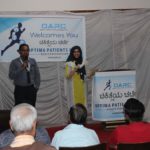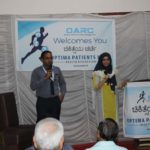Between 400,000 and 3.1 million adults have Sjögren’s syndrome. This condition can affect people of any age, but symptoms usually appear between the ages of 45 and 55. It affects 10 times as many women as men. About half of patients also have rheumatoid arthritis or other connective tissue diseases, such as lupus.
In the early 1900s, Swedish physician Henrik Sjögren (SHOWgren) first described a group of women whose chronic arthritis was accompanied by dry eyes and dry mouth. Today, rheumatologists (/IAmA/Patient Caregiver/HealthCareTeam/WhatisaRheumatologist) know more about the syndrome that is named for Sjögren and—most significantly for patients—can offer advice about how to live with it.
Fast Facts
Sjögren’s syndrome is an autoimmune condition that can occur at any age, but is most common in older
women. Many patients develop Sjögren’s syndrome as a complication of another autoimmune disease, such as rheumatoid arthritis or lupus
Symptoms vary in type and intensity, but many people with Sjögren’s are able to live normal lives.
Most of the treatment for Sjögren’s syndrome is aimed at relieving symptoms of dry eyes and mouth and preventing and treating longterm complications such as infection and dental disease. Treatments often do not completely eliminate the symptoms of dryness.
Most patients with Sjögren’s syndrome remain healthy, but some rare complications have been described, including an increased risk for cancer of the lymph glands (lymphoma). Thus, regular medical care and follow up is important for all patients.
What is Sjögren’s syndrome?
Sjögren’s syndrome is an inflammatory disease that can affect many different parts of the body, but most often affects the tear and saliva glands. Patients with this condition may notice irritation, a gritty feeling, or painful burning in the eyes. Dry mouth (or difficulty eating dry foods) and swelling of the glands around the face and neck are also common. Some patients experience dryness in the nasal passages, throat, vagina and skin. Swallowing difficulty and symptoms of acid reflux are also common.
“Primary” Sjögren’s syndrome occurs in people with no other rheumatic disease. “Secondary” Sjögren’s occurs in people who have another rheumatologic disease, most often systemic lupus erythematosus (/IAm A/PatientCaregiver/DiseasesConditions/Lupus) and rheumatoid arthritis (/IAmA/Patient Caregiver/DiseasesConditions/RheumatoidArthritis). It can occasionally be confused with a newly described syndrome call IGG4 disease.
Most of the complications of Sjögren’s syndrome occur because of decreased tears and saliva. Patients with dry eyes are at increased risk for infections around the eye and may have damage to the cornea. Dry mouth may cause an increase in dental decay, gingivitis (gum inflammation), and oral yeast infections (thrush) that may cause pain and burning. Some patients have episodes of painful swelling in the saliva glands around the face.
Complications in other parts of the body can occur. Pain and stiffness in the joints with mild swelling may occur in some patients, even in those without rheumatoid arthritis or lupus. Rashes on the arms and legs related to inflammation in small blood vessels (vasculitis) and inflammation in the lungs, liver, and kidney may occur rarely and be difficult to diagnose. Numbness, tingling, and weakness also have been described in some patients. The parotid gland is at the edge of the jaw and can become swollen and inflamed in some people with Sjögren’s Syndrome.
What causes Sjögren’s syndrome?
The cause of Sjögren’s syndrome is not known, but it is an autoimmune disorder. People with this disease have abnormal proteins in their blood. This suggests that the immune system, which normally functions to protect the body against cancers and infections, is reacting against its own tissue. The decrease in tears and saliva seen in Sjögren’s syndrome occurs when the glands that produce these fluids are damaged by inflammation. Research suggests that genetic factors and possibly viral infections may predispose people to developing this condition.
How is Sjögren’s syndrome diagnosed?
Diagnosis depends on a combination of symptoms, physical examination, blood tests, and sometimes special studies. Dry eyes and mouth may be early signs of the condition but require further investigation, because these symptoms can be caused by many other conditions or medications. Special tests may assess any decrease in tear or saliva production. An eye examination is helpful in detecting any eye changes seen in Sjögren’s. Blood tests can determine the presence of antibodies (immune system proteins that help destroy foreign invaders) typical of the disease. Typical antibodies include antinuclear antibodies (ANA) (/IAm A/PatientCaregiver/DiseasesConditions/AntinuclearAntibodiesANA), antiSSA and SSB antibodies or rheumatoid factor, but these are not always present. Biopsies of saliva glands around the face or under the surface of the inner lip also may be used to make a diagnosis.
How is Sjögren’s syndrome treated?
Treatment is designed to lessen the most bothersome symptoms. Dry eyes usually respond to artificial tears applied regularly during the day or to gels applied at night. Other measures, such as plugging or blocking tear ducts, can be used in more severe cases. Eye drops that reduce inflammation in the glands around the eyes, such as cyclosporine (Restasis), may be used to increase tear production. Drinking water, chewing gum, or using saliva substitutes may relieve dry mouth. Some patients benefit from using prescription medications that stimulate saliva flow, such as pilocarpine (Salagen) or cevimuline (Evoxac). If patients develop yeast infections, antifungal therapies may be used. Humidifiers and nasal saline irrigation may improve nasal dryness. Medications that reduce gastric acid (such as protonpump inhibitors and H2 blockers) may lessen symptoms of acid reflux. Treatments may help relieve some of the dryness, but usually some dryness persists.
All patients should receive regular dental care to prevent cavities and tooth loss that may occur as a complication of Sjögren’s. Patients with dry eyes should see an ophthalmologist (eye doctor) regularly for signs of damage to the cornea. Patients with excessive redness and pain in the eyes should be evaluated for infections.
Hydroxychloroquine (/IAmA/PatientCaregiver/Treatments/HydroxychloroquinePlaquenil) (Plaquenil), an antimalarial drug used in lupus and rheumatoid arthritis, may be helpful in some patients with Sjögren’s syndrome by reducing joint pain and rash experienced by some patients. Patients with rare but serious
systemic symptoms, such as fever, rashes, abdominal pain, or lung or kidney problems, may require treatment with corticosteroids such as prednisone (Deltasone and others) and/or immunosuppressive agents like methotrexate (/IAmA/PatientCaregiver/Treatments/MethotrexateRheumatrexTrexall) (Rheumatrex), azathioprine (/IAmA/PatientCaregiver/Treatments/AzathioprineImuran) (Imuran), mycophenolate (/IAm A/PatientCaregiver/Treatments/MycophenolateMofetilMycophenolateSodium) (Cellcept) or cyclophosphamide (/IAmA/PatientCaregiver/Treatments/CyclophosphamideCytoxan) (Cytoxan). In addition, researchers are evaluating rituximab (Rituxan) and other biological therapies to treat cases of Sjögren’s that affect the entire body.
Broader health impact of Sjögren’s syndrome
A vast majority of patients with Sjögren’s syndrome remain very healthy, without any serious complications. Patients should know that they face an increased risk for infections in and around the eyes and an increased risk for dental problems due to the longterm decrease in tears and saliva.
Rarely, patients may have complications related to inflammation in other body systems, including:
Joint and muscle pain with fatigue
Lung problems that may mimic pneumonia
Abnormal liver and kidney function tests
Skin rashes related to inflammation of small blood vessels
Neurologic problems causing weakness and numbness
In a small number of people, Sjögren’s syndrome may be associated with lymphoma, a cancer of the lymph glands.
Living with Sjögren’s syndrome
Sjögren’s syndrome cannot be cured, but in many cases proper treatment helps to alleviate symptoms. Rheumatologists (/IAmA/PatientCaregiver/HealthCareTeam/WhatisaRheumatologist) are specialists in musculoskeletal disorders and, therefore, are more likely to make a proper diagnosis. They also can advise patients about the best treatment options available.
People with Sjögren’s syndrome usually are able to live normal lives with very few adjustments. When a diagnosis is made, many patients must focus a great deal of attention dealing with dry eyes and dry mouth, but these symptoms tend to subside with time. Any pain or redness in the eyes should be evaluated promptly, as this may signal an infection. To reduce risk for cavities and other dental problems, patients must pay close attention to proper oral hygiene and regular dental care.
Patients should see their physician regularly for general health screening. They also should pay close attention to any abnormal swelling in the glands around the face or neck, under the arms, or in the groin areas, as this may be a sign of lymphoma.
Updated May 2015. Written by Christopher Wise, MD, and reviewed by the American College of Rheumatology Communications and Marketing Committee. This information is provided for general education only. Individuals should consult a qualified health care provider for professional medical advice, diagnosis and treatment of a medical or health condition.
© 2015 American College of Rheumatology
© 2015 American College of Rheumatology. All rights reserved.













